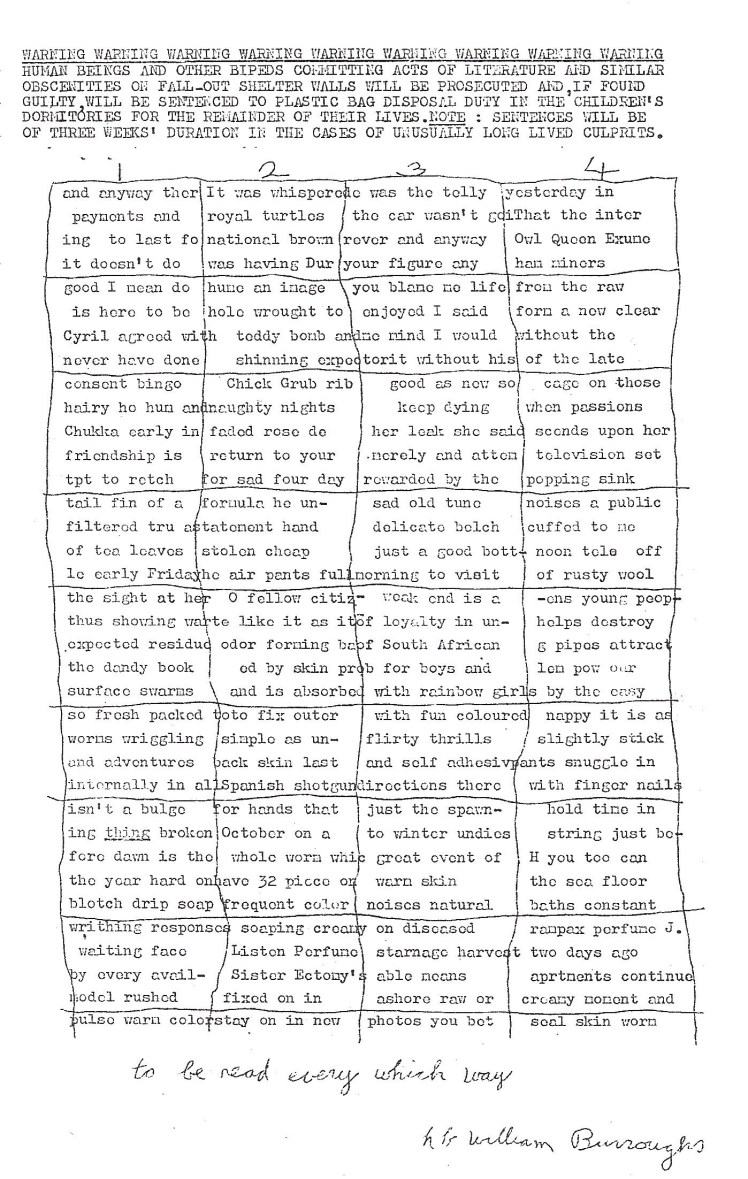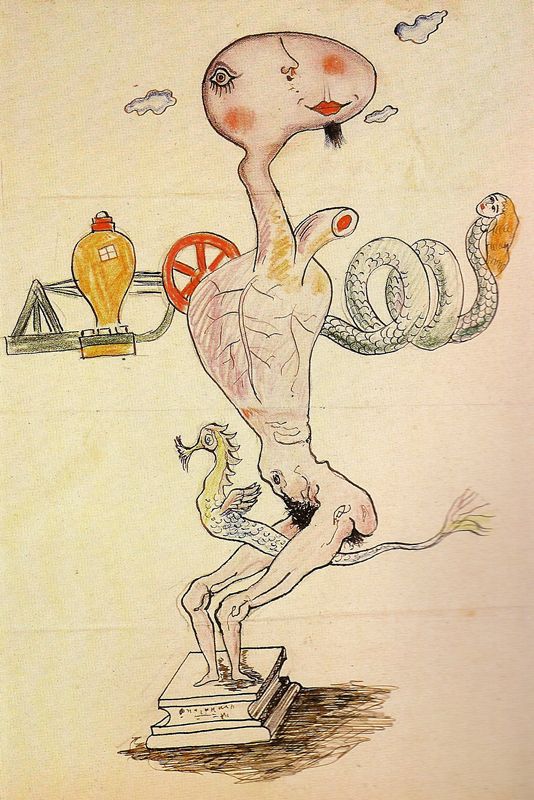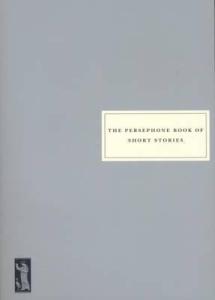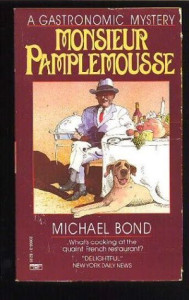In the post, I would like to reflect on an alternative creative methodology known as ‘Cut-Ups’ and how they may be applied to the production of non-linear sequential visual narratives. Originally, I became aware of the concept of ‘Cut-Ups’ through the BBC Documentary ‘Cracked Actor’, in which musician David Bowie spoke about his use of the method to create lyrics for his songs. Bowie would cut up books and newspaper articles and then rearrange and assemble these ‘Cut-Up’ phrases and sentences in unusual and interesting ways. As Bowie puts it “What I’ve used it for more than anything else is igniting anything that might be in my imagination. And you can often come up with very interesting attitudes to look into.” (Bowie, Glass, 2015)
The origins of this technique can be traced back to the early 20th Century Dadaist movement of the European avant-garde and its founder, Tristan Tzara. Tzara devised a method of creating a new form of poetry by pulling words from a hat and creating an instant poem with the resulting assembly.
In his manifesto, ‘Seven Dada Manifestos and Lampisteries’, Tzara “called on writers to make chance an essential agent of the composition process: ‘Take a newspaper. / Take some scissors’.” (Tzara 1977, p.39 cited Weidner 2013, p.315)
The process required the poet to pick an article, cut it up, place the words into a hat and then pull them out one by one to create a new work. This form was accidentally adopted by artist Brion Gysin and shared with his collaborator and writer friend William Burroughs “who enthusiastically saw the results as revelatory in creating a new writing method.” (Weidner 2013, p.315)
Burroughs went on to write the novels ‘The Soft Machine’, ‘The Ticket That Exploded’, and ‘Nova Express’ trilogy using the cut-up method.
 Fig.01: Burroughs, W. (2014). Cut Up Manuscript. [image] Available at: http://www.dazeddigital.com/artsandculture/gallery/18375/2/william-s-burroughs [Accessed 23 Nov. 2017].Surrealism preceded the method with a visual equivalent in the form of a parlour game called the Exquisite Corpse. The game required different collaborators to add to a collection of words or images in sequence either continuing a drawing either by only seeing the end of the previous collaborator’s contribution or following a specific rule.
Fig.01: Burroughs, W. (2014). Cut Up Manuscript. [image] Available at: http://www.dazeddigital.com/artsandculture/gallery/18375/2/william-s-burroughs [Accessed 23 Nov. 2017].Surrealism preceded the method with a visual equivalent in the form of a parlour game called the Exquisite Corpse. The game required different collaborators to add to a collection of words or images in sequence either continuing a drawing either by only seeing the end of the previous collaborator’s contribution or following a specific rule.
In both its written and visual form, the cut-up removes control on behalf of the author or artist akin to surrealist automatism and introduces an element of chance, thus challenging the conventions of narrative and mechanical forms.
 Fig.02: Tanguy, Y., Ray, M., Morise, M. and Breton, A. (1928). CADAVRES EXQUIS. [Drawing, Collage].With regards to sequential art, graphic novelist and comics artist Charles Burns of ‘Black Hole’ fame, has used the technique in his most recent work, ‘X’ed Out’. In a recent panel discussion, Burns spoke of his use of the technique and the influence of William Burroughs on his work. Burns said of the cut-up technique, “Yeah, it is taken from the William Burroughs writing, the idea of treating writing as a collage, cutting up your writing and reassembling it, which some people found very irritating.” (Burns, Chute, 2014)
Fig.02: Tanguy, Y., Ray, M., Morise, M. and Breton, A. (1928). CADAVRES EXQUIS. [Drawing, Collage].With regards to sequential art, graphic novelist and comics artist Charles Burns of ‘Black Hole’ fame, has used the technique in his most recent work, ‘X’ed Out’. In a recent panel discussion, Burns spoke of his use of the technique and the influence of William Burroughs on his work. Burns said of the cut-up technique, “Yeah, it is taken from the William Burroughs writing, the idea of treating writing as a collage, cutting up your writing and reassembling it, which some people found very irritating.” (Burns, Chute, 2014)
Burns expanded on this concept by creating random fragment booklets titled ‘Free Shit’ to hand out to people at conventions. He was inspired when someone came up to him at a comic convention and asked him if he got any free shit and he responded by producing a paper printed, folded and stapled booklet containing notebook drawings, comments and notes.
Burns and Bowie are two creatives whose work I appreciate and to find that they have incorporated a similar working method sparked my interest in exploring the technique. That it is a tried and tested methodology associated with the production of non-linear narratives and surrealist imagery makes a perfect fit with my chosen keyword and area of research.
Figures
Burroughs, W. (2014). Cut Up Manuscript. [image] Available at: http://www.dazeddigital.com/artsandculture/gallery/18375/2/william-s-burroughs [Accessed 23 Nov. 2017].
Tanguy, Y., Ray, M., Morise, M. and Breton, A. (1928). CADAVRES EXQUIS. [Drawing, Collage].
References
BBC (2016). How David Bowie used ‘cut ups’ to create lyrics – BBC News. Available at: https://www.youtube.com/watch?v=6nlW4EbxTD8 [Accessed 23 Nov. 2017].
Weidner, C. (2013). ‘Mutable Forms: The Proto-ecology of William Burroughs’ Early Cut-ups’, Comparative American Studies, 11, 3, pp. 314-326, Humanities International Complete, EBSCOhost, viewed 22 November 2017.
En.wikipedia.org. (2017). Exquisite corpse. [online] Available at: https://en.wikipedia.org/wiki/Exquisite_corpse [Accessed 23 Nov. 2017].
DiMaggio, K. (2011). Seceding from the Narrative. International Journal of the Book, 8(1), pp.11-18.
Chute, H. (2014). Panel: Graphic Novel Forms Today Charles Burns, Daniel Clowes, Seth, Chris Ware. Critical Inquiry, 40(3), pp.151-168.
Glass, I. (2015). Burroughs 101. [podcast] This American Life. Available at: https://www.thisamericanlife.org/radio-archives/episode/546/burroughs-101 [Accessed 22 Nov. 2017].
Advertisements Share this:




